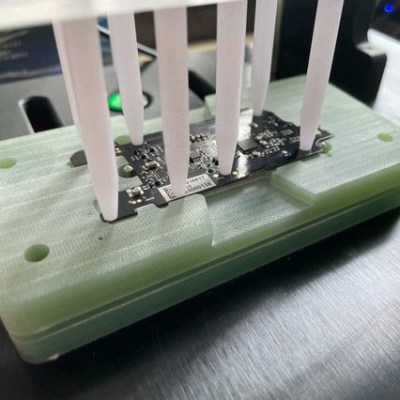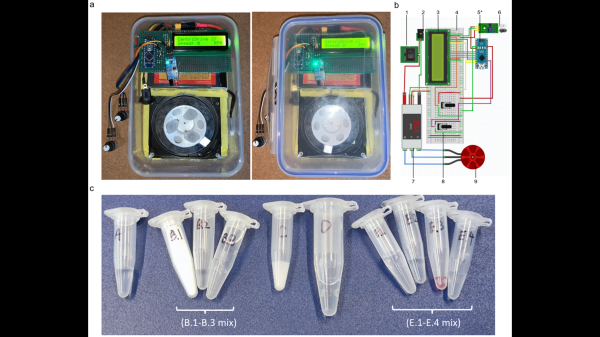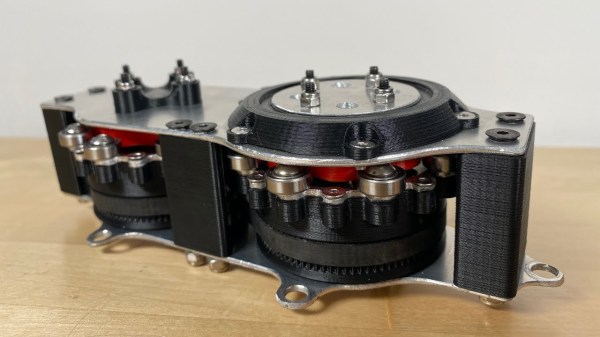“Don’t worry, that’ll buff right out.” Alarming news this week as the James Webb Space Telescope team announced that a meteoroid had hit the space observatory’s massive primary mirror. While far from unexpected, the strike on mirror segment C3 (the sixth mirror from the top going clockwise, roughly in the “south southeast” position) that occurred back in late May was larger than any of the simulations or test strikes performed on Earth prior to launch. It was also not part of any known meteoroid storm in the telescope’s orbit; if it had been, controllers would have been able to maneuver the spacecraft to protect the gold-plated beryllium segments. The rogue space rock apparently did enough damage to be noticeable in the data coming back from the telescope and to require adjustment to the position of the mirror segment. While it certainly won’t be the last time this happens, it would have been nice to see one picture from Webb before it started accumulating hits.
testing71 Articles
Theory, Practice, And Ducted Fans
About a year ago, [Wyman’s Workshop] needed a fan. But not just a regular-old fan, no sir. A ducted fan. You know, those fancy fan designs where the stationary shroud is so close to the moving fan blades that there’s essentially no gap, and a huge gain in aerodynamic efficiency? At least in theory?
Well, in practice, you can watch how it turned out in this video. (Also embedded below.) If you’re more of a “how-to-build-it” type, you’ll want to check out his build video — there’s lots of gluing 3D prints and woodworking. But we’re just in it for the ducted fan data!
And that’s why we’re writing it up! [Wyman] made a nice thrust-testing rig that the fan can pull on to figure out how much force it put out. And the theory aimed at 652 g of thrust, which was roughly confirmed. And then you get to power: with a 500 watt motor, he ended up producing 47 watts. Spoiler: he’s overloading the motor, even though he used a fairly beefy bench grinder motor.
So he re-did the fan design, from scratch, to better match the motor. And it performed better than the theory said it would. A pleasant surprise, but it meant re-doing the theory, including the full volume of the fan blade, which finally brought theory and practice together. Which then lead him design a whole slew of fan blades and test them out against each other.
He ends the video with a teaser that he’ll show us the results from various inlet profiles and fan cones and such. But the video is a year old, so we’re not holding our breath. Still, if you’re at all interested in fan design, and aren’t afraid of high-school physics, it’s worth your time.
Don’t care about the advantages of ducted fans, but simply want to make your quad look totally awesome? Have we got the hack for you!
Stress-Testing An Arduino’s EEPROM
Every time one of us flashes an Arduino’s internal memory, a nagging thought in the backs of our minds reminds us that, although everything in life is impermanent, nonvolatile re-writable memory is even more temporary. With a fixed number of writes until any EEPROM module fails, are we wasting writes every time we upload code with a mistake? The short answer is that most of us shouldn’t really be concerned with this unless we do what [AnotherMaker] has done and continually write data until the memory in an Arduino finally fails.
The software for this is fairly simple. He simply writes the first 256 ints with all zeros, reads them to make sure they are all there, and then repeats the process with ones. After iterating this for literally millions of times continuously over the course of about a month he was finally able to get his first read failure. Further writes past this point only accelerated the demise of the memory module. With this method he was able to get nearly three million writes before the device failed, which is far beyond the tens or hundreds of thousands typically estimated for a device of this type.
To prove this wasn’t an outlier, [AnotherMaker] repeated the test, and did a few others while writing to a much smaller amount of memory. With this he was able to push the number of cycles to over five million. Assuming the Arduino Nano clone isn’t using an amazingly high-quality EEPROM we can safely assume that most of us have nothing to worry about and our Arduinos will be functional for decades to come. Unless a bad Windows driver accidentally bricks your device.
HDD Centrifuge Puts COVID-19 Testing Lab In A Backpack
Throughout this two-year global COVID-19 nightmare, one thing that has been sorely lacking is access to testing. “Flu-like symptoms” covers a lot of ground, and knowing if a sore throat is just a sore throat or something more is important enough that we’ve collectively plowed billions into testing. Unfortunately, the testing infrastructure remains unevenly distributed, which is a problem this backpack SARS-CoV-2 testing lab aims to address.
The portable lab, developed by [E. Emily Lin] and colleagues at the Queen Mary University of London, uses a technique called LAMP, for loop-mediated isothermal amplification. LAMP probably deserves an article of its own to explain the process, but suffice it to say that like PCR, LAMP amplifies nucleic acid sequences, but does so without the need for expensive thermal cycling equipment. The kit contains a microcentrifuge that’s fashioned from an e-waste hard drive, a 3D printed rotor, and an Arduino to drive the motor and control the speed. The centrifuge is designed to run on any 12 VDC source, meaning the lab can be powered by a car battery or solar panel if necessary. Readout relies on the trusty Mark I eyeball and a pH-indicating buffer that changes color depending on how much SARS-CoV-2 virus was in the sample.
Granted, the method used here still requires more skill to perform than a simple “spit on a stick” rapid antigen test, and it’s somewhat more subjective than the “gold standard” quantitative polymerase chain reaction (qPCR) assay. But the method is easily learned, and the kit’s portability, simple design, and low-cost construction could make it an important tool in attacking this pandemic, or the next one.
Thanks to [Christian Himmler] for the tip.
Keep Scraps Around
When I’m building something, I like to have a decent-sized scrap pile on hand. Because when I’ve got to test something out — does this glue adhere to this fabric, how much force will this hold if I tap it and put a screw in, will it snap if reinforced with carbon fiber and epoxy — it’s nice to have some of the material in question on hand just for experimentation. So I pull a chunk out of the scrap pile!
But scrap piles can’t expand forever, and we all know that “too much of a good thing” is a thing, right? Scrap piles require constant pruning. You don’t really need more than a few aluminum extrusion cutoffs, so when you start building up excess inventory, it’s time to scrap it. I mean, throw it away.
A corollary of this, that I’ve only recently started to appreciate, is that if I limit the number of materials that I’m working with, it’s a lot more manageable to keep the scrap pile(s) under control. It’s simple math. If I’m working with twenty different materials, that’s twenty different heaps of scrap. But if I can get by with one weight of fiberglass for everything, that one pile of scraps can do double or triple duty. There is also the added benefit that I already know how the material works, and maybe even have old test samples on hand.
Indeed, I’m such a scrapaholic that it’s almost painful to start working with a new material and not have a scrap pile built up yet. I’m always loathe to cut into a nice square piece of stock just to test something out. But this too is part of the Great Circle of Life. By not testing things out beforehand, I’m almost guaranteed to screw up and create scrap out of what I had hoped was going to be a finished piece. See? No problem! Next version.
What do you think? Are scrap, offcuts, and their close cousins — test pieces and samples — worth keeping around in your shop? Do you have a disciplined approach, or do you just throw them in the corner? Purge per project, or only when the mountain of XPS foam gets as high as your head?
How The Flipper Zero Hacker Multitool Gets Made And Tested
Flipper Zero is an open-source multitool for hackers, and [Pavel] recently shared details on what goes into the production and testing of these devices. Each unit contains four separate PCBs, and in high-volume production it is inevitable that some boards are faulty in some way. Not all faults are identical — some are not even obvious — but they all must be dealt with before they end up in a finished product.

Designing a process to effectively detect and deal with faults is a serious undertaking, one the Flipper Zero team addressed by designing a separate test station for each of the separate PCBs, allowing detection of defects as early as possible. Each board gets fitted into a custom test jig, then is subjected to an automated barrage of tests to ensure everything is as expected before being given the green light. A final test station gives a check to completed assemblies, and every test is logged into a database.
It may seem tempting to skip testing the individual boards and instead just do a single comprehensive test on finished units, but when dealing with production errors, it’s important to detect issues as early in the workflow as possible. The later a problem is detected, the more difficult and expensive it is to address. The worst possible outcome is to put a defective unit into a customer’s hands, where a issue is found only after all of the time and cost of assembly and shipping has already been spent. Another reason to detect issues early is that some faults become more difficult to address the later they are discovered. For example, a dim LED or poor antenna performance is much harder to troubleshoot when detected in a completely assembled unit, because the fault could be anywhere.
[Pavel] provides plenty of pictures and details about the production of Flipper Zero, and it’s nice to see how the project is progressing since its hyper-successful crowdfunding campaign.
Differential Drive Doesn’t Quite Work As Expected
Placing two motors together in a shared drive is a simple enough task. By using something like a chain or a belt to couple them, or even placing them on the same shaft, the torque can be effectively doubled without too much hassle. But finding a way to keep the torque the same while adding the speeds of the motors, rather than the torques, is a little bit more complicated. [Levi Janssen] takes us through his prototype gearbox that attempts to do just that, although not everything works exactly as he predicts.
The prototype is based on the same principles as a differential, but reverses the direction of power flow. In something like a car, a single input from a driveshaft is sent to two output shafts that can vary in speed. In this differential drive, two input shafts at varying speeds drive a single output shaft that has a speed that is the sum of the two input speeds. Not only would this allow for higher output speeds than either of the two motors but in theory it could allow for arbitrarily fine speed control by spinning the two motors in opposite directions.
The first design uses two BLDC motors coupled to their own cycloidal drives. Each motor is placed in a housing which can rotate, and the housings are coupled to each other with a belt. This allows the secondary motor to spin the housing of the primary motor without impacting the actual speed that the primary motor is spinning. It’s all a lot to take in, but watching the video once (or twice) definitely helps to wrap one’s mind around it.
The tests of the drive didn’t go quite as planned when [Levi] got around to measuring the stall torque. It turns out that torque can’t be summed in the way he was expecting, although the drive is still able to increase the speed higher than either of the two motors. It still has some limited uses though as he notes in the video, but didn’t meet all of his expectations. It’s still an interesting build and great proof-of-concept otherwise though, and if you’re not clear on some of the design choices he made there are some other builds out there that take deep dives into cycloidal gearing or even a teardown of a standard automotive differential.
Continue reading “Differential Drive Doesn’t Quite Work As Expected”


















